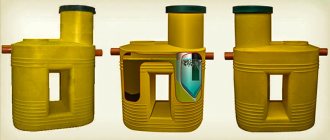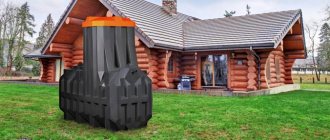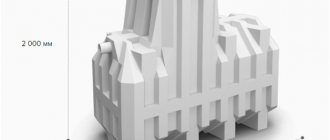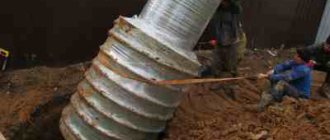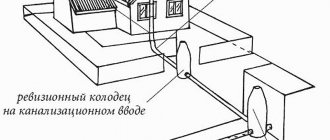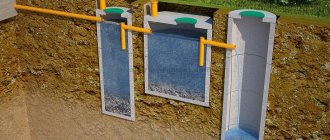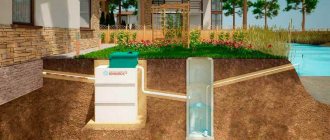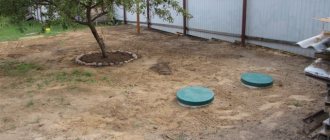The BioDeka septic tank was developed in 2014 according to a simplified design by Jan Topol, and combines the best properties of the stations: Deka, Eurobion. The specifications of the cleaning device comply with current standards:
- daily water consumption rate - 200 l/user;
- the volume of oxygen required for the oxidation of organic matter is 60 g;
- degree of water purification 98%.
Sewage is processed biologically, by saturating water with oxygen. Air is supplied to the system by a tubular aeration element.
The best wastewater treatment technology
The BioDeka septic tank uses a single-mode operating scheme. The supply line is connected to the receiving unit above the critical level, ensuring maximum salvo discharge. The outlet of the outlet pipe is provided from the secondary sludge stabilizer. In gravity-flow installations, the outlet (Ø11 cm) is realized in the factory. Forced-type septic tanks are equipped with an outlet tube (Ø2.5 cm) during installation.
The following simultaneously participate in single-mode operation:
- compressor device;
- main airlift connecting the receiver to the aeration tank;
- “purging” the coarse filter of the main pump in the primary chamber;
- coarse-bubble aeration device in the receiver;
- fine bubble aeration in the aeration tank;
- airlift recirculation between secondary settling tank, sludge stabilizer;
- collection of greasy film in the secondary settling tank;
- “blowdown” in the sludge stabilizer.
The process of wastewater treatment goes through 3 stages: gravitational separation of solid fractions, biological processing of organic matter, secondary sedimentation - precipitation of sludge.
Contaminated water enters the receiving unit, undergoes primary oxidation, large fractions are crushed, mixed with clarified liquid, sludge mass from the settling tank using a coarse-bubble aerator. From the receiver, the wastewater passes through a Ø110 mm filter pipe into the aeration tank. Under the influence of fine-bubble aeration, biological wastewater treatment occurs. Saturation of liquid with oxygen promotes the vital activity of aerobes.
The aeration tank houses a removable pyramidal container with a truncated bottom - a secondary stabilizer. The sludge that falls to the bottom of the secondary settling tank is transferred to the primary stabilizer by a recirculation airlift. The top fatty layer of the secondary clarifier is absorbed by the biofilm remover. The composition is deprived of floating gases and settles in the secondary stabilizer.
Excess sludge is blown into the settling tank using a coarse bubble aerator. Dead colonies of bacteria are stabilized at the bottom of the stabilizer, suspended particles return by gravity to the receiving compartment through a removable pyramid. Clean water comes out of the secondary settling tank to the outside.
Product Features
Septic tanks have been produced for 14 years. The manufacturer claims that he was able to create a product that combines simplicity of design with reliability and operational efficiency.
Among the features of its products, the manufacturer highlights:
- Robust cylindrical body with one polymer weld.
- The design of the septic tank does not use magnetic valves and float switches, which, according to experience in operating autonomous sewer systems, most often fail.
- The design of the products allows you to easily convert the unit from a gravity installation to a forced water pumping system.
- Some models can operate in climate zones with very low air temperatures due to the insertion depth of the pipes increased to 180 cm.
Popular septic tank models
Advantages of the BioDeka septic tank
The deep biological treatment station satisfies the requirements of SNiP and the needs of modern residents of private houses with positive characteristics:
- There is no need to call a sewer truck to pump out waste sludge. The built-in airlift will help you carry out the procedure yourself (2-3 times/year).
- There is no need to use bacterial additives. Aerobic bacteria reproduce independently due to aeration and a stable supply of organic matter.
- The technically pure water at the outlet is suitable for watering lawns and garden crops.
- The station operates autonomously. Septic tank maintenance is carried out 2 times a year for temporary residence in a country house, in a private house, once a year for year-round use.
- In winter, the septic tank does not freeze thanks to additional insulation, stable water circulation, and the activity of bacteria that produce heat.
- The installation occupies a minimum of usable space on the site. 1-1.5 m2 is enough. A green square hatch fits perfectly into the landscape of a private home.
- The wastewater undergoes biological treatment without fermentation; there is no unpleasant odor in BioDeka septic tanks.
A deep biological treatment station requires a stable supply of electricity to support the operation of compressors and pumps. Average electricity consumption is 1.4 kW/day. Short-term power outages will not affect the organic processing process.
Installation
Installation work for the unit includes the following steps:
- Choosing a location on the site. It is better to place the septic tank deck at the point with the lowest surface level. This will facilitate the work of laying sewer supply pipes while maintaining the required slope level for drainage. However, one should take into account sanitary standards, according to which treatment facilities can be located no closer than 5 meters from the house.
- Preparing the pit and digging supply trenches. The dimensions of the pit should be larger than the unit, so that there is 15-20 centimeters left on all sides for backfilling. Due to the fact that the depth of the pit is quite large, in areas with unstable soil, it is recommended to install formwork. The bottom of the pit should be leveled and covered with a layer of sand.
- The installation is lowered into the pit. Pipelines are connected.
- The position of the unit is checked for level.
- The space between the device body and the walls of the pit is simultaneously filled and the container is filled with clean water.
Selection of BioDeca modifications
The BioDeka line of septic tanks is designed for specific operating conditions: gravity systems are successfully used on sandy, slurry soils; complex soils require forced removal of clean water through a pump. The marking displays the type of clean water drainage accordingly: S – gravity, P – forced. The second option is equipped with a block for installing a drainage pump. An additional reservoir is located in the BioDeka receiving compartment, above the water surface. Users purchase the pump themselves. The universal placement of BioDeki units allows you to convert a gravity station into a forced septic tank without special tools.
Modifications of the BioDeka septic tank differ in the depth of insertion of the supply pipes. Residents of private houses are offered a choice of standard and extended options. The technical parameters of extended septic tanks are similar to standard stations, only the insertion depth differs:
- "BioDeka" 3 - maximum 60 cm;
- "BioDeka" 5, 8 - 80, 130, 180 cm;
- "BioDeka 10" - 80, 100, 150 cm.
The marking of septic tanks also determines the number of conditional consumers. For example:
- "BioDeka 3" - serves 3 people;
- "BioDeca 5" satisfies the needs of 5 people;
- "BioDeka 8" is designed for a private house accommodating 8 residents.
The standard length of the outlet pipe of gravity septic tanks is 55 cm.
Operation and Maintenance
To ensure smooth operation of the installation, you must follow a few simple rules. These include:
- do not allow debris to enter the tank, which could lead to blockage;
- Do not pour substances into the unit that can lead to the death of microorganisms: chlorine-based disinfectants, antibiotics, petrochemical products.
Also, periodically, it is necessary to carry out maintenance - empty the sedimentation tanks of accumulated sludge. You can do this yourself, using a fecal or drainage pump, or contact a company that carries out such work. Cleaning is carried out no more than twice a year.
"Biodeka 3"
The Biodeka 3 septic tank with a capacity of 500 l/day will be the best treatment facility for 1-3 users. The design accepts waste from toilets, sinks, and shower stalls; the permissible volume is 140 l/hour. The energy consumption of the unit is 1.32 kW/day. The compact dimensions of the treatment plant (1.06x1.06x1.84) make it easy to connect a septic tank in a small area of a private house. There are 2 modifications available for users to choose from: “BioDeka-3 C-600”, “BioDeka-3 P-600”. Price range: 71-73 thousand rubles. The maximum insertion depth of the supply pipe is 60 cm. If the sewer line runs lower, it is necessary to raise the supply pipe or look for modifications that feature an elongated body.
"Biodeka 4"
The BioDeka 4 septic tank is successfully used when installing an autonomous sewer system in a private house accommodating 4 people. The tank uninterruptedly processes waste from the toilet, sink, sink, shower, washing machine, and dishwasher. The daily output of VOCs is 800 liters, the volume of salvo discharge exceeds the dimensions of a standard bath - 190 liters. The container dimensions (LxWxH) are 106x106x209 cm, weight 120/125. The connection height of the inlet pipe is 70 cm, the outlet pipe is 40 cm. The daily energy consumption reaches 1.56 kW. The line of stations includes gravity, forced options: “BioDeka S-4”, “BioDeka P-4”. The cost of the products is 78-80 thousand rubles.
"Biodeka 5"
BioDeca 5 is the best-selling product produced by Deca. Suitable for families of 3-5 people, with a consumption of 200 l/day for one resident of a private house. The unit's volley discharge capacity is 250 liters - the optimal indicator for connecting a shower stall, sink, toilet, washing machine, and dishwasher.
Modifications of the Biodeka 5 septic tank:
Biodeka 5 S-800, Biodeka 5 P-800 for a private house correspond to dimensions (LxWxH): 106x106x234 cm, price 85-88 thousand rubles.
Biodeka 5 S-1300, Biodeka 5 P-1300 has dimensions (LxWxH) 106x106x284 cm, cost 93-95 thousand rubles.
Biodeka 5 S-1800, Biodeka 5 P-1300 has parameters (LxWxH) 106x106x334 cm, prices are 121-124 thousand rubles.
"Biodeka 8"
BioDeka 8 is an autonomous treatment facility with a capacity of 1600 l/day. The station is used by 8 residents of private houses, consuming 200 l/day. Peak discharge of “BioDeki 8” is 380 l. Sewage water treatment corresponds to the best BOD5 indicators - 98.4%. The septic tank is connected at a height of 80-180 cm, depending on the selected modification.
The choice is presented by the 6 best VOCs for a private home:
Biodeka 8 S-800, Biodeka 8 P-800. Purchasing a station with dimensions (LxWxH) 135x135x235 cm will cost 107-109 thousand rubles. (price of gravity, forced construction, respectively).
Biodeka 8 C-1300, Biodeka 8 C-1300. Dimensions of the extended modification (LxWxH) 135x135x285 cm, cost 122-125 thousand rubles.
Biodeka 8 S-1800, Biodeka 8 S-1800. Side parameters (LxWxH) 135x135x335 cm, cost 140,142 thousand rubles.
Advantages and disadvantages
Before purchasing any product, it is worth finding out about its existing advantages and disadvantages. This also applies to septic tanks, because each of them has its own specific pros and cons.
Advantages
First, let's take a look at the advantages of septic tanks of this brand:
- wastewater treatment by 98%;
- environmental Safety;
- absence of unpleasant odors;
- simple and reliable design;
- practically does not clog;
- high strength – cylindrical body with one technological seam;
- relatively light weight;
- long service life;
- affordable price.
Flaws
The main disadvantage of the Biodeka septic tank, as well as other VOCs, is its dependence on electricity. If there is a power outage, the station simply will not work, so at this time it is better to reduce the use of water, otherwise there is a high risk of flooding the septic tank.
You may be interested in information on other septic tanks:
Decepticon
Topas 5
Unilos
Rules for installing a septic tank
Using toilet paper for septic tanks

